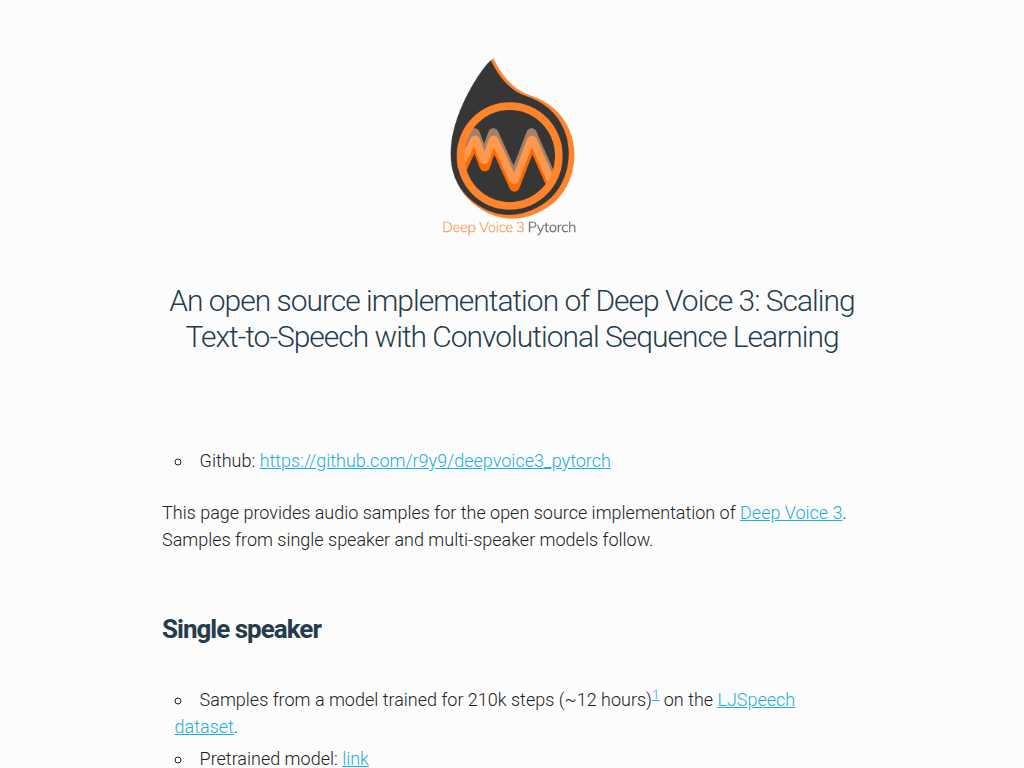Deep Voice 3
Text-To-Speech

Revolutionize Speech Synthesis with Deep Voice 3's Advanced TTS Technology.
Average rated: 0.00/5 with 0 ratings
Favorited 0 times
Rate this tool
About Deep Voice 3
Deep Voice 3 (DV3) represents the cutting-edge in text-to-speech (TTS) technology, developed by Baidu Research. Its primary function is to convert text into high-quality, natural-sounding speech, harnessing an innovative fully convolutional attention-based neural architecture. This design allows for significantly faster training rates and enhanced scalability compared to previous TTS models, establishing DV3 as a leader in the field [1](https://r9y9.github.io/deepvoice3_pytorch/)[2](https://www.nextplatform.com/2017/10/30/deep-voice-3-ten-million-queries-single-gpu-server/). Key features of DV3 include its architecture, which is divided into three core components: the encoder, the decoder, and the converter. The encoder is responsible for transforming textual features into a learned internal representation using a fully convolutional network. This method supports parallel processing, thus expediting training times [1](https://r9y9.github.io/deepvoice3_pytorch/). The decoder employs multi-hop convolutional attention to transform this representation into a low-dimensional audio format. Finally, the converter, which is non-causal, utilizes a post-processing network to predict final vocoder parameters, allowing for the integration of future context information to enhance prediction accuracy [3](https://paperswithcode.com/method/deep-voice-3). The tool finds applications across various domains, such as assistive technologies, customer service, entertainment, education, interactive voice response systems, and IoT applications. It can synthesize speech for chatbots and virtual assistants, create characterized voices in video games, and provide pronunciation guides in educational tools, among other uses [7](https://toolnest.ai/project/deep-voice-3/). DV3 offers significant advantages over similar tools, highlighting its rapid training time, scalability to large datasets (e.g., 800+ hours from 2000 speakers), and superior output quality matching state-of-the-art systems. These features culminate in its ability to handle millions of queries per day on a single GPU server. The architecture also mitigates common attention errors seen in attention-based TTS models, further enhancing its functionality [2](https://www.nextplatform.com/2017/10/30/deep-voice-3-ten-million-queries-single-gpu-server/)[9](https://openreview.net/forum?id=HJtEm4p6Z). Technical specifications for DV3 depend on the specifics of the chosen implementation, with open-source versions available on platforms like PyTorch. These versions provide flexibility in hardware and software requirements based on the data volume being trained [1](https://r9y9.github.io/deepvoice3_pytorch/)[4](https://github.com/r9y9/deepvoice3_pytorch). Due to its open-source nature, DV3 can be integrated into a variety of systems and platforms, though the seamlessness of integration will vary by system and the specific DV3 implementation used [4](https://github.com/r9y9/deepvoice3_pytorch). The model's debut at the International Conference on Learning Representations (ICLR) 2018 has earned it significant academic attention and numerous citations, underscoring its impact on TTS research, even though specific awards are not detailed in the sources [10](https://www.semanticscholar.org/paper/Deep-Voice-3%3A-Scaling-Text-to-Speech-with-Sequence-Ping-Peng/feca3f41b5b4cc13368d53f3168cc55a2420ec16). While the primary focus remains on DV3's initial architecture, the documentation does not indicate recent updates or developments. Further investigation would be needed to uncover any new advancements or enhancements to the model since its release.
Key Features
- Fully-convolutional architecture enabling fast training
- Three main components: Encoder, Decoder, Converter
- Supports multi-speaker synthesis with speaker embeddings
- Produces high-quality, natural-sounding audio
- Efficient training process, ten times faster than prior models
- Robust attention mechanism maintaining alignment
- Scalable query handling, managing up ten million queries daily
- Integrates with vocoders like WaveNet and Griffin-Lim